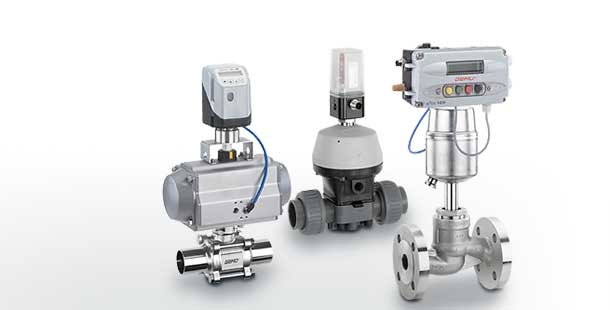How Control Valves Effect Energy Effectiveness in Industrial Settings
How Control Valves Effect Energy Effectiveness in Industrial Settings
Blog Article

Maximize Power Savings and Comfort With Advanced Structure Automation Controls
In the realm of modern style and center administration, the assimilation of innovative building automation controls stands as a critical improvement. By taking advantage of the power of automation, buildings can adapt, react, and evolve in methods that were once unthinkable.
Power Performance Perks
Power efficiency advantages can substantially reduce power usage and functional costs in buildings. Energy-efficient systems, such as advanced structure automation controls, can maximize the use of resources like home heating, lighting, and cooling, leading to reduced energy expenses over time.
Moreover, boosted power performance can prolong the life-span of structure devices and systems. By operating more effectively, heating and cooling systems, light, and various other structure components experience much less wear and tear, resulting in minimized upkeep and substitute expenses. Additionally, energy-efficient buildings often regulate higher building values and rental prices, giving long-lasting financial benefits to proprietors.
Moreover, power efficiency can improve resident comfort and productivity. Effectively regulated indoor settings with optimal lights and thermal conditions create an even more favorable and enjoyable work area, causing enhanced employee fulfillment and performance. Generally, the power performance benefits connected with innovative building automation controls are multifaceted, including expense savings, ecological stewardship, and passenger wellness.
Improved Convenience Control
Enhancing comfort control in structure atmospheres requires a sophisticated integration of sophisticated automation systems for ideal owner health. By using sophisticated building automation controls, facilities can customize the interior atmosphere to fulfill the certain demands and preferences of residents. These systems make it possible for accurate guideline of illumination, temperature level, and air flow, producing a comfy and productive atmosphere. Resident satisfaction and efficiency are carefully connected to thermal comfort, making it vital to have systems in location that can adapt to changing problems in real-time.
By including these advanced controls, buildings can not just boost convenience however likewise enhance energy efficiency by enhancing system procedures based on real occupancy and usage patterns. Eventually, focusing on passenger comfort through advanced automation systems leads to a more satisfying and much healthier indoor setting.
Functional Performance Improvements

Moreover, the implementation of real-time tracking and analytics tools allows structure operators to recognize power inefficiencies and operational abnormalities immediately. By constantly monitoring energy usage patterns and system efficiency metrics, changes can be made in real-time to enhance power consumption and make certain peak functional performance. control valves. In addition, including need action approaches right into building automation controls can further improve functional efficiency by dynamically changing power usage based on grid conditions and pricing signals
Indoor Environment Optimization
Efficient interior environment optimization is an essential facet of building automation controls, guaranteeing occupants' convenience and well-being while optimizing energy cost savings. By making use of innovative sensing units and controls, developing automation systems can continuously change and check temperature level, moisture levels, air top quality, and air flow to produce an ideal indoor setting. Maintaining regular and comfy conditions not just enhances passenger complete satisfaction but additionally enhances efficiency and general health.
Indoor climate optimization also plays an essential duty in power efficiency. By fine-tuning air flow, heating, and cooling systems based upon real-time information and occupancy patterns, constructing automation controls can substantially minimize energy usage - control valves. Executing methods such as demand-controlled air flow and thermal zoning can aid lessen power waste while making certain that each area of the structure receives the required conditioning.

Lasting Setting Development
Structure automation manages not only maximize interior environment problems for power effectiveness and occupant convenience yet also lay the foundation for producing a sustainable environment through strategic administration of sources and systems. By incorporating advanced structure automation technologies, such as sensing units, actuators, and intelligent software, facilities can monitor and adjust energy usage in real-time to lessen waste and reduce their carbon footprint. These systems make it possible for anticipating upkeep, identifying prospective problems before they rise and enhancing devices performance to improve Read More Here durability and performance.
Additionally, lasting environment development expands beyond power administration to include water conservation, waste decrease, and interior air top quality improvement. Building automation controls can control water usage, identify leakages, and make sure appropriate waste disposal practices, adding to overall sustainability initiatives. Additionally, by controlling and checking air flow and filtration systems, these innovations enhance passenger wellness and efficiency while lowering power consumption connected with a/c procedures.
Final Thought
In conclusion, advanced building automation manages offer significant benefits in regards to energy financial savings, comfort control, functional performance, indoor environment optimization, and creating a lasting environment. By carrying out these controls, structures can attain ideal performance while lowering power usage and enhancing passenger convenience. It appears that using advanced automation modern technology is crucial in boosting building efficiency and producing a more lasting future.
Power effectiveness advantages can significantly lower power usage and operational expenses in buildings. In general, the energy efficiency advantages connected with sophisticated building automation controls are multifaceted, including expense financial savings, ecological stewardship, and occupant well-being.
In addition, including demand feedback strategies into building automation controls can better improve operational efficiency by dynamically changing energy usage based on grid problems and rates signals.
Structure automation controls not just enhance indoor environment problems for energy efficiency and owner comfort yet additionally lay the structure for developing a sustainable atmosphere via strategic management of resources and systems.In conclusion, progressed structure automation manages deal substantial advantages in terms of power savings, convenience control, operational performance, indoor climate optimization, and see it here creating a sustainable setting.
Report this page